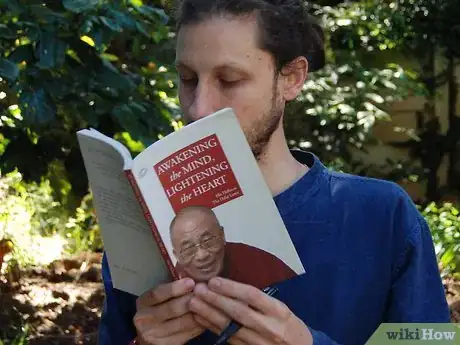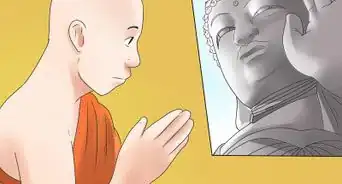wikiHow is a “wiki,” similar to Wikipedia, which means that many of our articles are co-written by multiple authors. To create this article, 25 people, some anonymous, worked to edit and improve it over time.
wikiHow marks an article as reader-approved once it receives enough positive feedback. This article received 11 testimonials and 94% of readers who voted found it helpful, earning it our reader-approved status.
This article has been viewed 192,691 times.
Learn more...
Tibetan Buddhism is a very complete form of Buddhism containing a subtle and advanced philosophy, clear step by step instructions for meditation, devotional exercises and physical meditations that work like Tai Chi, as well as much more.
Steps
-
1Read as many of the Dalai Lama's books as possible. The most essential are "Essential Teachings," "The World of Tibetan Buddhism," "Mind of Clear Light," "The Art of Happiness," "An Open Heart," "How to Practice," and "The Path To Enlightenment." The Dalai Lama is one of the most scholarly, most humble and best Buddhist practitioners in the world, at least among those that are widely known.
-
2Be patient. The philosophical teachings in Tibetan Buddhism, especially the teaching on imputation by mind, are very subtle and difficult to grasp and will likely take years, or at the very least several months, of study and contemplation before they start to really make sense and apply to your personal experience in a real way. Keep going. Keep studying, keep contemplating what you've read and memorized (memorizing important quotes from Buddhist scriptures that the Dalai Lama quotes in his books is an important step to understanding and ingraining the philosophical ideas of Tibetan Buddhism into your mind), keep meditating.Advertisement
-
3Meditate. It doesn't matter so much what meditation you do. What is important is that you practice meditation every single day; the longer you do it within any given day, the better, but it's very important to realize that if you overdo it on one day you are likely to do less meditation on the next day (the Yin-Yang principle in action) so it's best to do the same amount of meditation every day, and increase the amount of time you meditate gradually if you want to do more.
-
4Realize that higher teachings are worthless if you can't even practice the most basic teachings, such as ethics (avoiding the ten non-virtuous actions). So you should start with ethics and do your best to start with the most basic teachings first and master them, or at least get a good grounding with them, before moving on to higher teachings.
-
5Think of Tibetan Buddhism as being like a pyramid. It starts with the foundation of the Hinayana for a stable base, then it builds on the Hinayana with the altruistic motivation of the Mahayana and its practice of the Six Paramitas, then it builds on the base of the Hinayana and Mahayana with the Vajrayana which is the pinnacle of Tibetan Buddhism and the main daily practice of serious Tibetan Buddhist practitioners. The way this works is similar to how the realization of impermanence, suffering, and no-self (wisdom) in Hinayana Buddhism is dependent on achievement of concentration which is itself dependent upon the practice of morality (keeping of the precepts).
-
6Know that Tibetan Buddhism contains teachings for people of all different kinds of dispositions, it has advanced philosophical teachings for those of an intellectual bent, it has more mystical experiential meditative teachings for those of a more Zen-like orientation, and it has energy practices (in Vajrayana) for moving wind (prana, chi, ki) for health and mental clarity and spiritual realization, this is like Tai Chi and Hindu yoga (for those who want a Buddhist practice with emphasis on the health of the physical body). Tibetan Buddhism also deals with the subtle drops as well as prana in the practice of Vajrayana. This makes it similar in some respects to Hindu yoga which also deals with the drops (Bindu). No matter what kind of person you are, it is likely that there are teachings in Tibetan Buddhism that would be suited for your type of personality or mental/emotional/physical/spiritual orientation. Also, the different deities (Buddhas and Bodhisattvas) are for people with different types of spiritual inclinations or personalities. For those who are intellectual, the teachings of Manjushri are very appropriate; for those who aren't very intellectual but are very kind and compassionate, the practice of Avalokiteshvara would be very good; for women, practice of the deity Tara (a female deity) would be good; and for those interested in power, Vajrapani (who represents of the power of the buddhas) might be a good deity.
-
7Learn about the Lamrim and practice the basics first.
-
8Make a strong and sustained effort to learn about and generate Bodhicitta in your mind and heart, Bodhicitta is one of the most important aspects of Tibetan Buddhism, (although not a distinguishing aspects, as all Mahayana Buddhists are defined as such by possessing Bodhicitta). Tibetan Buddhism has a more clear definition of Bodhicitta than other forms of Mahayana, and Tibetan Buddhism also has more clearly defined and developed techniques for developing Bodhicitta than other forms of Mahayana.
-
9Practice the Tonglen everyday to develop compassion and create positive karma
-
10Find a Tibetan Lama or Rinpoche to teach you even further than you could by yourself, especially if you want certain empowerments. You should try to get a teaching from the Karmapa or the Dalai Lama.
Community Q&A
-
QuestionCan I practice Tibetan Buddhism without understanding it?
 Community AnswerPractice comes from a desire to attain something. As you practice, you will refine your understanding. That refined understanding then refines your practice. That's good enough! But for your practice to become really effective, you should find a teacher. Not just any teacher, but a teacher that elevates you and speaks to your inner sense.
Community AnswerPractice comes from a desire to attain something. As you practice, you will refine your understanding. That refined understanding then refines your practice. That's good enough! But for your practice to become really effective, you should find a teacher. Not just any teacher, but a teacher that elevates you and speaks to your inner sense. -
QuestionHow would I practice the tantric aspects of Vajrayana?
 Community AnswerYou must have a teacher to practice the Vajrayana; it is the highest level of Buddhist teachings. There are many who claim that they are able to impart such knowledge, so be selective in who you choose to teach you.
Community AnswerYou must have a teacher to practice the Vajrayana; it is the highest level of Buddhist teachings. There are many who claim that they are able to impart such knowledge, so be selective in who you choose to teach you. -
QuestionHow do I cultivate compassion and forgiveness?
 Community AnswerBegin by showing compassion and forgiveness with yourself. Let yourself off the hook.
Community AnswerBegin by showing compassion and forgiveness with yourself. Let yourself off the hook.
Warnings
- You get out of it what you put into it. Just because you intellectually know the most advanced philosophical outlook in the world doesn't make you a more advanced person than anyone else. What matters is how ethical, mentally acute, and emotionally and actively compassionate you are. To have the teachings of Tibetan Buddhism change your life you need to give them a lot of your time and effort and remember and apply them in your daily life.⧼thumbs_response⧽
- Tibetan Buddhism is a huge religion. There are a lot of scriptures, deities, principles, practices, meditations, teachers, and history. It can be overwhelming. It will take a long time to read even just the main scriptures through once, let alone several times so that you are intimately familiar with them. It is probably best to just read and memorize a few short and essential scriptures that you can work with everyday.⧼thumbs_response⧽
- Once again, be patient. It takes a long time. Even just learning and practicing Hinayana Buddhism (Theravada) is involved and takes a fair amount of time. Tibetan Buddhism contains a lot of Hinayana, plus all of Mahayana, and then plus it also contains and emphasizes Vajrayana (aka Mantrayana, aka Tantrayana or Tantra).⧼thumbs_response⧽
Things You'll Need
- A Qualified Teacher - someone who has been on the path for some time to offer guidance and help you through common obstacles.















-Step-10-Version-3.webp)





















































